#pierre brun
Text
Brun: Bory. This is too far.
Bory: This is for science!
Lameth: You are playing with fire, my friend~
Saint-Chamans: I'm clearly the most popular! My memoirs are actually available on the internet!
Petiet: Mine is more exclusive..!
Pierre Soult: Not sure how I feel about being included here. And what about Anthoine and Franceschi?
Bory: They don't appear on this Web Log so much, so they are not options! And neither is our good friend C͞i̗̱̻̳̟̲͢ͅt̮͢o̳͓̣͉̥̘ye̱n O͞m̢̖̯̪̙̬b̛r̰͓͙̬̭̖è, for he is not as, ahem, historical as us~
Lameth: Anthoine is too innocent to be exposed to the internet! We keep him away from such things~
Brun: And Franceschi has better things to do with his time. This is stupid, however. Obviously I'm the best. I'm the one who actually went to Napoleon and convinced him of Soult's good intentions during that awful Roi Nicolas stuff.
Lameth: But I died tragically and young, and that gives me a certain charm, non?
Bory: My plan is working! Unfortunately, Coco has passed out drunk again and cannot defend himself, but ah well.
Anyway, as the completely impartial poll host, I simply must point out that I am a very famous naturalist renowned for my scientific discoveries, and a certain Monsieur Darwin carried my book with him on his voyages. So, ah, do keep that in mind!
#napoleonic shitpost#napoleonic shitposting#napoleonic fandom#napoleonic roleplay scene#marshalate ballot#the duke of dalmatia's aides de camp#adc brun de villeret#adc petiet#adc lameth#adc saint-chamans#adc bory de saint-vincent#adc pierre benoit soult
10 notes
·
View notes
Text
Explaining one of VTMB paintings (pt 5)
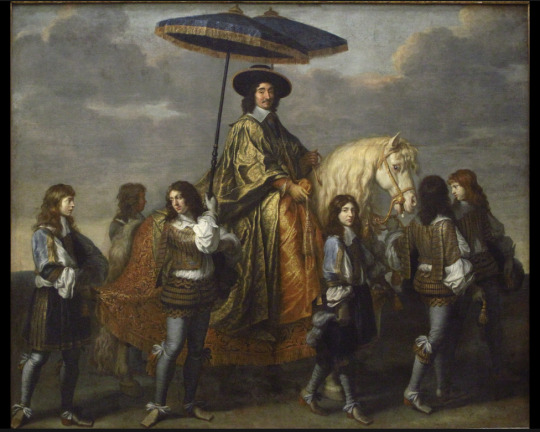
Pierre Séguier, Chancelier de France (translated Pierre Séguier, Chancellor of France) oil on canvas 2nd quarter of the 17th century (1660 - 1661) by Charles Le Brun
Charles Le Brun (baptised 24 February 1619 – 12 February 1690) was a French painter, physiognomist, art theorist, and a director of several art schools of his time. As court painter to Louis XIV, who declared him "the greatest French artist of all time", he was a dominant figure in 17th-century French art and much influenced by Nicolas Poussin Le Brun primarily worked for King Louis XIV, for whom he executed large altarpieces and battle pieces. His most important paintings are at Versailles. Besides his gigantic labours at Versailles and the Louvre, the number of his works for religious corporations and private patrons is enormous. Le Brun was also a fine portraitist and an excellent draughtsman, but he was not fond of portrait or landscape painting, which he felt to be a mere exercise in developing technical prowess. What mattered was scholarly composition, whose ultimate goal was to nourish the spirit. The fundamental basis on which the director of the Academy-based his art was unquestionably to make his paintings speak, through a series of symbols, costumes and gestures that allowed him to select for his composition the narrative elements that gave his works a particular depth. For Le Brun, a painting represented a story one could read.[1]
Pierre Séguier (May 28, 1588,- Jan. 28, 1672) was the chancellor of France under kings Louis XIII and Louis XIV, in the critical period during which monarchical power was consolidated. In 1635 Séguier became chancellor of France, the supreme legal officer, with tenure of that dignity for life. His adherence to the powerful cardinals Richelieu and Mazarin kept him in uninterrupted exercise of his functions until 1650. He was sent in 1637 to Val-de-Grâce to examine the papers of the queen of France, Anne of Austria, who was suspected of secretly corresponding with Spain. Some historians say he saved her by warning her of the investigation. In 1639 he was sent to supervise the repression of a revolt in Normandy. He presided in 1642 over the trial of the Marquis de Cinq-Mars, who was condemned to death for conspiring against Richelieu.During the revolt of the Fronde, Séguier, like many others, vacillated, and in the last phase of the Fronde in Paris he was aligned with the rebel princes until August 1652. During those troubles, he was twice relieved of his functions (1650–51 and 1651–56). Early in the personal reign of Louis XIV, in December 1662, he was put in charge of the trial of the finance minister, Nicolas Fouquet, who had been accused of embezzlement, and he conducted it brutally enough to secure a verdict against Fouquet. From 1665 he presided over the new Council of Justice for the reform of the legal system.[2]
This painting hangs in LaCroix's office next to his entrance way meaning it is one of the painting he looks directly at, and hangs next to the painting of Louis XIV en Empereur Romain [Louis XIV depicted as Alexander the Great] (second half of 17th century) by Unknown artist. First off for someone who “was an officer in Napoleons army” he sure has a lot of Royalists paintings. It is also of note as the only other large paintings of this scale that he has in his office are three different painting of Cain slaying his brother Able by different artist yet it is the paintings of King Louis XIV (whose reign of 72 years and 110 days is the longest of any sovereign in history whose date is verifiable.) and his chancellor of France, Pierre Séguier that he looks directly at from his desk in his Versailles style office. Indicating that these mere HUMAN men*[as far as I know nether were embraced in VTM canon but don’t quote me] are more significant role models to Lacroix then Cane father of all vampires. Though this is not so surprising after you see how he reacts to the Ankaran Sarcophagus. It also gives us a brief glimpse into how LaCroix sees himself in his role as the Camarilla Prince of Los Angles calling back to his quote of being the “judge, jury and executioner”.
[1] “Charles Le Brun .” Wikipedia, Wikimedia Foundation, 11 Mar. 2023, https://en.wikipedia.org/wiki/Charles_Le_Brun.
[2] Britannica, The Editors of Encyclopaedia. "Pierre Séguier". Encyclopedia Britannica, 24 Jan. 2023, https://www.britannica.com/biography/Pierre-Seguier
#vtmb#Vampire The Masquerade Bloodlines#sebastian lacroix#Pierre Séguier#art history#Charles Le Brun#Explaining one of VTMB paintings
22 notes
·
View notes
Text
100+ Famous Modern Art Artists of All Time
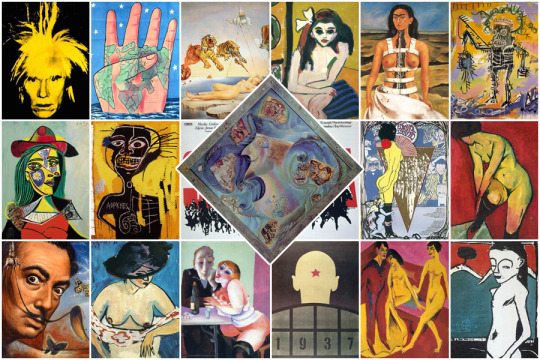
2/8/2024
Framed Poster Print
Canvas Print
Metal Print
Acrylic Print
Wood Prints
Worldwide shipping
#Élisabeth Vigée Le Brun#Jean-Antoine Watteau#georges seurat#jean michel basquiat#tamara de lempicka#paul gauguin#paul cézanne#helen frankenthaler#Sophie Matisse#katsushika hokusai#edward hopper#Pierre-Auguste Renoir#peter paul rubens#el greco#egon schiele#francisco goya#marc chagall#gustave courbet#caravaggio#png
5 notes
·
View notes
Text
The Fall of Fouquet
Of those who sat in Louis XIV's council in March 1661, Nicolas Fouquet was beyond a shadow of a doubt the most charismatic and flamboyant. His background was typical of the upwardly mobile noblesse de robe, and his family like so many others had invested a fortune accumulated as drapers merchants in ennobling office. Fouquet’s grandfather and his father, François, had both served as judges in the Parlement of Paris, and his mother, Marie de Maupeou, was herself a member of another rising robe clan. The family had acquired an impressive reputation for piety, and its links to Saint Vincent de Paul, the parti dévot, and the Compagnie du Saint-Sacrement had opened additional doors to the powerful. All six of Marie’s surviving daughters entered the religious life, as would three of her five sons. Nicolas, on the other hand, was destined for a career in royal service, joining first the Parlement of Metz, and then, following the route trekked by countless aspiring young robins, by purchasing the office of maître des requêtes and serving as an intendant, attracting the attention of Mazarin in the process. In 1650, he had bought the prestigious office of procureur général in the Parlement of Paris, and having proved himself scrupulously loyal to Mazarin he was rewarded with the post of surintendant des finances in 1653.
As surintendant he was responsible for government fiscal policy in the aftermath of the Fronde and was charged with finding the funds needed to prosecute the seemingly endless war with Spain, proving remarkably able and helping to secure a French victory consummated in the Peace of the Pyrenees of November 1659. Anyone capable of surviving for long in the cut-throat world of seventeenth-century finance was, almost by definition, talented, and no less certain to become fabulously rich. Fouquet was no exception, and by 1661 he had added prodigious wealth to an already substantial family fortune that was made manifest in the construction of the beautiful château of Vaux-le-Vicomte, only a few miles from the royal palace of Fontainebleau. Designed by the architect Louis Le Vau and with its interiors decorated by Charles Le Brun, Vaux-le-Vicomte was an aesthetic triumph set within majestic gardens, created by André Le Nôtre, complete with ornamental fountains that have rightly been seen as an inspiration for Versailles. A man of taste and refinement, Fouquet forged a reputation as a generous artistic patron, and, amongst others, Molière, Pierre Corneille, Jean de La Fontaine, and Paul Pellisson benefitted from the surintendant’s largesse. Despite his family’s impeccable dévot credentials, Nicolas moved in eclectic and heterodox intellectual circles, and, much to his mother’s chagrin, his reputed good looks and genuine charm had given him an established reputation as a gallant.
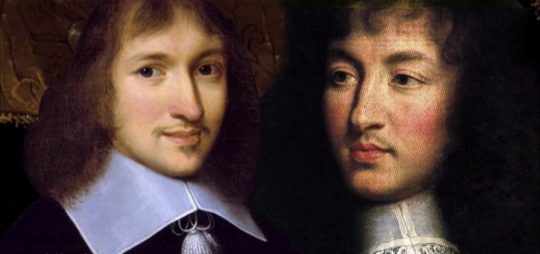
(Fouquet on the left, Louis XIV on the right)
Rich, self-confident, and having proved himself to be an able and loyal servant of the crown, Fouquet, at only forty-six years of age, had every reason to suppose that a long and profitable career stretched before him. His actions in the months following the cardinal’s death were certainly not those of a man harbouring any inner self-doubts. In August 1661, he agreed to sell his office of procureur général in the Parlement to his friend Achille de Harlay, presumably confident that his interests in the court would be well served as he also had close ties with its first president, Guillaume de Lamoignon. More dramatically, on 17 August 1661, Fouquet threw one of the most notorious parties in French history. Using the magnificence of Vaux-le-Vicomte as the setting, the guests, who included large swathes of the French governing elite, were treated to a sumptuous fête, with a theatrical performance directed by Molière, fireworks, and other entertainments all ostensibly in honour of the king. Popular tradition, reinforced by numerous literary and cinematic productions, maintains that Louis XIV, furious at being upstaged by a mere minister and convinced that such lavish display could only be at his own expense, swore revenge. Fouquet had undoubtedly been tactless as the interior of the château boasted a lavish state bedroom, complete with railed bed, which had been prepared as if the monarch was intending to be a regular guest of his munificent minister. Those aristocrats present were horrified that a mere robin should be so presumptuous and the king almost certainly shared their prejudices. If this was the case, he was nevertheless careful to conceal his fury and neither Fouquet nor contemporary witnesses interpreted events in quite the dramatic fashion of later commentators, and the minister continued to work almost daily with the king.
At the end of August, the monarch and his entourage began a tour of Brittany, timed to coincide with the assembly of the provincial estates. By now, the surintendant had received a number of quite explicit warnings about threats to his position and he was growing anxious. Despite his misgivings, he travelled to Nantes and while he was suffering from a fever the king had sent for news of his health, which must have helped to allay his fears. If Louis-Henri de Loménie de Brienne, who was present on the scene, is to be believed, Fouquet even had hopes that it would be Colbert who would be arrested and that his position was secure. On 5 September, the surintendant was well enough to work as normal with the king, but as he left the audience he was accosted by Charles d’Artagnan and a detachment of musketeers. D’Artagnan promptly arrested an astonished Fouquet, who is said to have exclaimed that ‘he thought that he held a higher place in the king’s esteem than anyone else in the kingdom’. If that was indeed the case, then it was a monumental misjudgement because he had just plunged into the most profound disgrace.

D'Artagnan (left) arrests Fouquet (right)
Almost immediately it became apparent that the fall of Fouquet was no momentary loss of favour. Instead it had been carefully premeditated over several months by Louis XIV and Jean-Baptiste Colbert, another aspiring robe noble who had made his fortune as the steward of Mazarin’s private fortune. Colbert not only replaced Fouquet at the head of government finances, but he also directed a trial that was intended to conclude in a death sentence against his imprisoned rival. Fouquet’s brothers, his wife, mother, and close associates were either arrested or exiled, his papers seized in circumstances that made a travesty of the law, and he was brought before a specially convoked commission, not the Parlement of Paris as would have been his right had he not sold his office to Achille de Harlay only a few weeks before. Fouquet had seriously undermined his own political position, and recent precedents were grim. Had Richelieu been directing affairs, Fouquet would have been fortunate indeed to escape the block. However, Colbert seems to have been determined to use Fouquet as a scapegoat for the endemic corruption that both men had profited from, and which had been one of the defining features of Mazarin’s ministry. Fouquet was therefore accused of péculat, an elastic term encompassing a wide range of financial misdemeanours. While burrowing around in Fouquet’s château of Saint-Mandé, the investigators also stumbled across some secret documents from 1658 outlining a strategy for revolt in the event of his arrest. Although it was clear that they were intended for use against Mazarin, not the king, it was decided to add the capital charge of lese-majesty to the existing accusations against the prisoner.
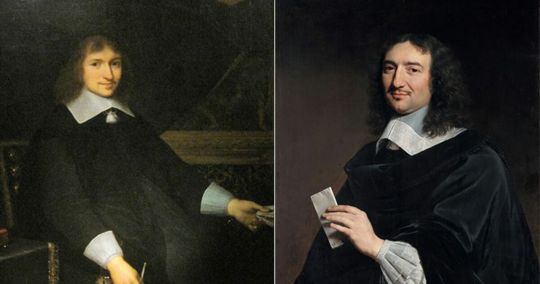
(Fouquet vs Colbert, there will be only one)
Raking up all manner of supposed earlier misdeeds against a disgracié was common practice. On this occasion it proved counterproductive, and had the government moved quickly it could conceivably have obtained a rapid judgement and the desired death sentence. Instead, it tried to dig up more and more evidence and the trial proper did not commence until 3 March 1662. Confronted by a complicated mass of financial accusations and with Fouquet putting up a spirited and effective defence of his actions, the case dragged on for over two years. Colbert and the king grew increasingly frustrated, meddling with legal procedure, seeking to intimidate judges and witnesses alike and making it clear that while they wanted to give the impression of a fair trial it should not be at the expense of a guilty verdict. Fouquet’s family and his many friends and admirers gradually recovered from the shock of his arrest and began an energetic campaign on his behalf, convincing a substantial part of public opinion that he was the victim of a vendetta. When the verdict was finally announced in December 1664, the judges did find the accused guilty of péculat, but rather than impose the death penalty as the government intended they voted by a small majority in favour of banishment and a substantial fine.
[..]
Fouquet’s spectacular fall is arguably the most dramatic and poignant example of the potentially calamitous consequences of ministerial disgrace. The first great political crisis of Louis XIV’s personal rule, it cast a long shadow and yet in many ways it marked the end rather than the beginning of a chapter as the age of the minister-favourite gave way to that of the secretary of state. Although Fouquet had escaped with his life, his draconian punishment was very much in the tradition of Louis XIII and Richelieu and arguably of late medieval monarchy. Rather than simply dismiss Fouquet and banish him from court, as a master would discard an unsatisfactory servant, Louis XIV had treated him as a criminal who had stolen from his treasury and plotted against his authority. It was a very political trial, one that brings to mind the treatment of Claude Barbin, following the murder of Concini, or that of the maréchal de Marillac, in the aftermath of the Day of Dupes. Indeed, Fouquet’s miserable existence in Pignerol almost bears comparison with that of cardinal Jean Balue, who according to popular legend was locked in an iron cage in the château of Loches after falling foul of Louis XI. The harsh treatment of Fouquet’s family and the confiscation of their property as well as the persecution of his friends and clients was again consistent with earlier practice, echoing in milder form the attacks on the Concini in 1617.
Julian Swann- Exile, Inprisonment or Death- The Politics of Disgrace in Bourbon France.

#xvii#julian swann#exile imprisonment or death: the politics of disgrace in bourbon france#louis xiv#nicolas fouquet#cardinal mazarin#la paix des pyrénées#louis le vau#charles le brun#jean baptiste poquelin#molière#jean de la fontaine#pierre corneille#paul pellisson#guillaume de lamoignon#achille de harlay#château de vaux le vicomte#jean baptiste colbert#d'artagnan#cardinal de richelieu#louis xiii#concino concini#claude barbin#maréchal de marillac
4 notes
·
View notes
Text

mirror #47
#black and white#paint#acrylic#acryliquepainting#artists on tumblr#abstract art#abstract#behr#mirror effect#mirror#stonewashed brown#brun lavé à la pierre#white city#ville blanche#the perception lab#art
0 notes
Text
the internet lies about how good many things are but I'm gonna be honest, buying a djungelskog is the best possible use of fifty australian dollars there is.
#his name is jean-pierre le brun and he's my favourite guy in the world#full disclosure i did not buy him with my own money he's a present from dad but i stand by my statements
0 notes
Text
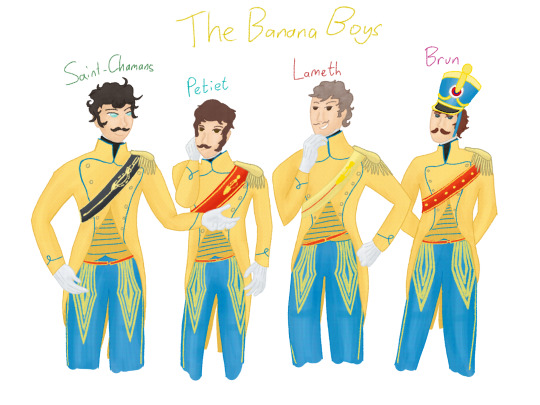
Presenting the Banana Boys the Aides-de-Camp of Marshal Jean-de-Dieu Soult, the excitable drunk collective blob military family of the grumpy asshole!
I’ve been enjoying reading about their shenanigans in @josefavomjaaga’s posts and wanted to draw them, especially as I’ve started having them appear in some writing snippets and RPs
From left to right we have
Alfred de Saint-Chamans, who once wondered why Napoleon was so interested in Soult’s ass and who thinks he deserves a medal too!
Auguste Petiet, who despite Soult being mean to him and not giving him a promotion because of a disagreement with Petiet's dad, is really proud of military daddy Soult
Alfred de Lameth, the jester who can't stop joking even when it offends Murat's wife and who got murked in Spain and made his fellow soldiers so sad they burned and slaughtered a village in revenge
Brun de Villeret, the sensible guy who got into a car crash because of Soult's distracted driving and who spent months trying to convince Napoleon that the rumours about Soult trying to make himself king in Portugal are mean rumours
I found references for all of them except Lameth, who died young and also his uncle is too famous so the image search is full of him and his stupid wig, so I pretty much just made up Lameth's appearance based on vibes.
There's more ADCs like Pierre Soult, the baby brother of Soult, Franceschi the Art Guy, Coco Lefebvre Who Physically Can't Stop Partying and others, but these four are probably the Main Characters in the writing I've done!
And also yeah Soult did decide that his assistants should be dressed in bright yellow shirts and sky blue pants.
#cadmus rambles#cadmus draws#jean de dieu soult#napoleonic wars#napoleonic era#alfred de saint-chamans#auguste petiet#alfred de lameth#brun de villeret#cad rambles about dead frenchmen on main
39 notes
·
View notes
Text


Self-Portrait - Raphael // Self-Portrait with a Green Vest – Eugène Delacroix // Self-Portrait – Diego Velázquez // Portrait of a Man (Self Portrait) – Jan van Eyck // Self-Portrait - Jean-Baptiste-Pierre Le Brun // Self-Portrait - Jacques-Louis David // Self-Portrait – Peter Paul Rubens // Mont Blanc and the Glacier des Bossons Looking Down the Arve Valley – JMW Turner // Self-Portrait – Elin Danielson-Gambogi // Self-Portrait - Gwen John // Self-Portrait as Saint Catherine of Alexandria – Artemisia Gentileschi // Self-Portrait in a Straw Hat – Élisabeth Louise Vigée Le Brun // Self-Portrait – Judith Leyster // Self-Portrait – Louise Hollandine of the Palatinate // Self-Portrait with Palette – Marie Bashkirtseff // La Rue des Clos Moreaux – Gwen John
#elin danielson gambogi#gwen john#artemisia gentileschi#elisabeth louise vigee le brun#judith leyster#louise hollandine of the palatinate#marie bashkirtseff#you're just a boy (and i'm kinda the man)#yjabaiktm#maisie peters#maisie peters the good witch#the good witch maisie peters#the good witch#art#art history#lyrics#lyric art
64 notes
·
View notes
Text
🌿🐑McHarrison Bucolic/Mythological AU🐑🌿
If Mclennon did Pyramus and Thisbe.
But listen, hear me out- McHarrison play as Endymion and Selene in Greek mythology.
Paul as a shepherd boy and George as a moon god since he played the moon in their Pyramus and Thisbe skit. But I also feel like George works well as a dryad nymph💖
PREMISE IDEA:
I could just make a pretty scene where Paul falls asleep tired from a day in herding sheep. He decides to take a nap under a tree unaware that it was a nymph who watched over him while he worked everyday.
One day George the nymph was feeling bold , instead of watching him while hiding among the trees, he went near the fences to get to meet him.
But hesitated when Paul looked in his direction so George immediately transformed to a tree so he wouldn't be caught.
I was getting inspired with pastoral and romanticist literature and paintings. This is just a character sheet , and mostly headcanons for the story.
Well, not really a story, more like a premise idea with glimpses of scenarios and ambiguous plotline. I was thinking of it being a combination of A Midsummer Night's Dream, myths like Pomona / Vertumnus, and Endymion. I came upon two poems that suit these two:
"The Passionate Shepherd to his Love" by Christopher Marlowe &
"The Nymph's reply to the Shepherd" by Walter Raleigh
I gained an appreciation towards Pre-Raphaelite and Rococo art because I just love the quaint and idyllic atmosphere. The French and Dutch masters are my most favorite. The way the French portray the countryside are so pretty and romanticised. Whereas the Dutch focused on actual folk art showing the daily lives of farmers.
The Pre-Raphaelites make forestlife look magical also. Favorite painters are Pierre Auguste Renoir, Pierre Auguste Cot, Peter Paul Rubens, Moritz Stifter, Vigee Le Brun etc.
I'm hoping to really get into drawing more so I could started with coming up of the actual composition for these characters.
Not really happy how the flowers and foliage turned out for the nymph. I suck at drawing leaves and plants😭

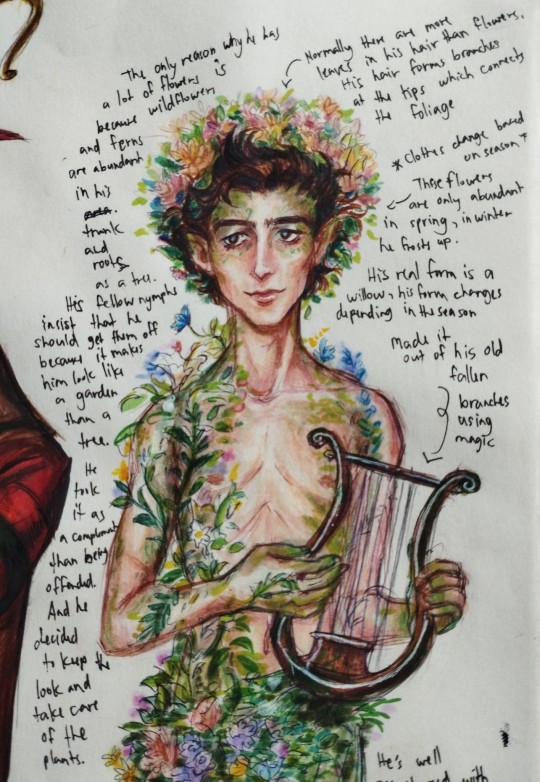





#mcharrison#beatles#the beatles#the beatles fanart#the beatles art#beatles art#beatles fanart#beatles slash#paul mccartney x george harrison#paul mccartney#george harrison#fairycore#greek mythology#roman mythology#dryad#fairy tale au#fairy#beatles au#cottagecore#pastoral art
39 notes
·
View notes
Text

Pierre Balmain Haute Couture Collection Fall/Winter 1954-55 Marie-Thérèse wears "Oriane", eggshell silk satin dress by Lesage inlaid with brown taffeta appliques and embroidered with gold thread motifs, golden cannetilles, brown chenille, mother-of-pearl and pearls by Lesage, large bow with long sides forming a train in matching brown taffeta.
inlaid with brown taffeta appliques and embroidered with patterns in gold thread, golden cannetilles, brown chenille, mother-of-pearl and pearls by Lesage, large bow with long sides forming a train in matching brown taffeta.
Pierre Balmain Collection Haute Couture Automne/Hiver 1954-55 Marie-Thérèse porte "Oriane", robe en satin de soie coquille d'oeuf de Lesage incrustée d'appliques de taffetas brun et brodée de motifs en fils d'or, cannetilles dorées, chenille brune, nacre et perles par Lesage, grand noeud à longs pans formant traîne en taffetas brun assorti.
incrustée d'appliques de taffetas brun et brodée de motifs en fils d'or, cannetilles dorées, chenille brune, nacre et perles par Lesage, grand noeud à longs pans formant traîne en taffetas brun assorti.
Photo Georges Saad.
#collection haute couture#fashion 50s#1954-55#fall/winter#automne/hiver#french designer#french style#pierre balmain#marie-thérèse#georges saad#lesage#evening gown#robe du soir
24 notes
·
View notes
Text
small and nameless things
as inspired by an extremely cute picture that @mandatorycommunistbrunchhour drew and drawing upon concepts that @phatburd introduced in phantoms of the opera
mildly gory, violent, eldritch, inspired by multiple things, not particularly comprehensible without context
—·—
Today, Citoyen Ombré was very small. It liked to be small when it was swimming next to Bory because Bory had the biggest smile when it was small. There were so many smiles back in the theatre of that cracked heart! But they were the same smiles, over and over, and the prima donna didn't even know them.
It had seen the prima donna a few more times from a distance. The prima donna was the closest thing it had to a parent, if a parent was something that made you from raw materials.
But from what it had listened to of the painted Soult speaking to his mistlike wife, a parent was meant to guide you and raise you into a proper member of society. There was no need for that in the theatre of the cracked heart because everything had been made into a tableau echo of the prima donna - society was immediately formed from that which had been there before, ready to welcome the prima donna in.
That was a reason why a writhing of collaborative tendrils had found it interesting when bilateral people came into the orchestra lair and started talking! And then after receiving such nice tasty food, it had received something even better - a name!
To name a thing is to force perception onto it. It isn't the only way - any sense and any understanding will do that - but it is a more permanent thing. Some do consider this to be violence. But Citoyen Ombré didn't much mind because it was so interesting and new!
And there were so many interesting and new things outside of the theatre of the cracked heart, and outside of where it had been before that - that place where nothingness swam in nothingness before names and numbers.
That was why Citoyen Ombré liked the painted Soult because the painted Soult was so nice, and so was that written Lameth and Caroline and that boney one, but mostly it liked Soult because Soult gave it a name and a choice. And so it concluded that Soult was a parent, though it still owed much to the prima donna of the theatre of the cracked heart.
It was sad it hadn't had the chance to show off its bilateral body plan to Soult because Soult was gone. Ah, well, that would be a nice surprise!
And it also liked the servants of the painted one like Lameth! They were a lot like tentacles but more independent. Only five of the servants had substance which was written and wasn't mistylike, but all of them were like... were like that word, which was uncle?
There was the three who were full of words - Saint-Chamans had hair that was just as everywhere as Citoyen Ombré's tentacles and was very funny, Petiet liked it when you patted him and paid attention to him and Brun was always trying to make sure everything was moving correctly. And then Lameth was copies of words but also was very funny.
But its favourite servant was Bory, who was full of wriggly lines. Some of the lines were like leaves but a lot of the lines were like lands. But even apart from that Bory was really interested in Citoyen Ombré and liked to make almost faithful representations of the parts of Citoyen Ombré! And when Citoyen Ombré as inspired by Brother Lenoir stretched and took on a bilateral symmetry, Bory was so fascinated he made even more representations!
What fun!
And now Citoyen Ombré was going to surprise Bory by staying outside of his perception and then abruptly entering it. A lot of the time that made Bory laugh.
But, here, there was something that wasn't Bory, and it wasn't Lameth or Saint-Chamans or Petiet or Brun, and it wasn't mistylike in the way that was like that existence before the theatre of the cracked heart so it wasn't like the nice Luise or Pierre or Franceschi, and it wasn't painted like Soult.
Oh, it was a thing. It had fivefold extremities and from four of those sprouted fivefold more, and it had a bilateral bodies like a lot of the other things here. It had what the nice Bory called biology, which has things like skin and veins and arteries and blood and bones, even if these things don't really line up because this is more of a land of narrative than of physics, this lands of the dead and the not-living.
Biology can coexist with other things, here. It's like how the painted Soult can breathe and talk and bruise, but can also crack apart into splinters.
So!
Citoyen Ombré was curious, and it was currently small, so it went up to the person and said bonjour.
The person turned to look at Citoyen Ombré, and it did not have eyes inside its biology. Instead, it had that which is not.
And to you and I, this not would look like void or space, or sometimes static or failure. To Citoyen Ombré, without eyes but with dark perception, this not was a lot like blinding terrifying light.
Normal sunlight will scatter the shadows and destroy what this thing of shadows is. What about a light that is not light, but is simply not?
So of course Citoyen Ombré was scared! Citoyen Ombré did not really know what the not was, even in that time before the theatre of the cracked heart, even in that time before names and numbers. It once thought maybe that the not was a lot like the darkness, but that's wrong.
Darkness is a name of that which lacks light, and therefore it is a something. And that was why Citoyen Ombré did not mind being named, because in the beginning, even in that time before names and numbers, when it was just potential and structure, it was always going to be made of the thing that would be called darkness.
The not is not anything, until the moment that you perceive it. Until that moment when you looked at it, or felt it, or heard it, or named it, it was innocent. And then, perhaps like the squall of a babe or the hiss of a scuttling thing, it will react.
If it can't get used to what you have done to it, then it will set itself against you for the crime you have committed against it.
With the brimming emptiness of what it wished it could be once again, the not-person reached out and tried to tear apart Citoyen Ombré into nothingness. But, Citoyen Ombré was fast, and it jumped into a shadow, quicker than closing curtains!
In the shadows, Citoyen Ombré was no longer very small, but was gathering whatever shadows it could, before it reached out with as many tendrils as it could and closed around the not-person and its biology, constricting and tightening as much as it could to stamp out all of that not and all of that surrounding biology.
And that was why, when it was small again, when Citoyen Ombré went up to Uncle Bory and surprised him, Bory was really surprised.
"Little Ombré, are you covered in blood?!"
And that was how Citoyen Ombré learned about "bathtime".
—·—
#napoleonic roleplay scene#descriptions narratives d'incidents enregistrés#citoyen ombré#signalements d’un ennemi de l’existence
9 notes
·
View notes
Note
Sending some aspirins to the banana boys just in case they need some.
Coco Lefebvre: WERE NOT GONNA NEED IT WERE GONNA DRINK UNTIL SOULT COMES BACK
Pierre Soult: I'm here!
Coco Lefebvre: MERDE RUN ITS THE FUZZ
Brun: Wrong Soult. Thank you, Anonyme. I'll take that.
#Anonymous#the duke of dalmatia's aides de camp#adc brun de villeret#adc coco lefebvre#adc pierre soult#event: the adcs are partying hard
3 notes
·
View notes
Text
ÉLISABETH VIGÉE LE BRUN 🥺❣️🎨
Élisabeth Vigée Le Brun was a remarkable woman and a talented painter who lived in a turbulent time.
- élisabeth was painting portraits professionally by her early teens, and became a member of the Académie de Saint-Luc at the age of 19.
- She married an art dealer, Jean-Baptiste-Pierre Le Brun, who helped her exhibit her work and gain access to the nobility, but also cheated on her and exploited her financially.
- She was a favourite of Marie Antoinette, and painted more than 30 portraits of the queen and her family, often in informal and intimate settings. She also painted a great number of self-portraits, in the style of various artists whose work she admired.
- She fled France during the Revolution, and travelled across Europe and Russia, painting portraits of royal patrons and influential figures. She was elected to art academies in 10 cities, and was praised by Catherine the Great of Russia.
- She returned to Paris in 1801, but did not like the social life under Napoleon. She moved to London, where she painted portraits of the court and Lord Byron. She also visited Switzerland, where she painted a portrait of Madame de Staël.
- She wrote her memoirs, which provide a lively account of her life and times. She died in Paris in 1842, at the age of 86.
35 notes
·
View notes
Text
Explaining One of VTMB Paintings (part 16)
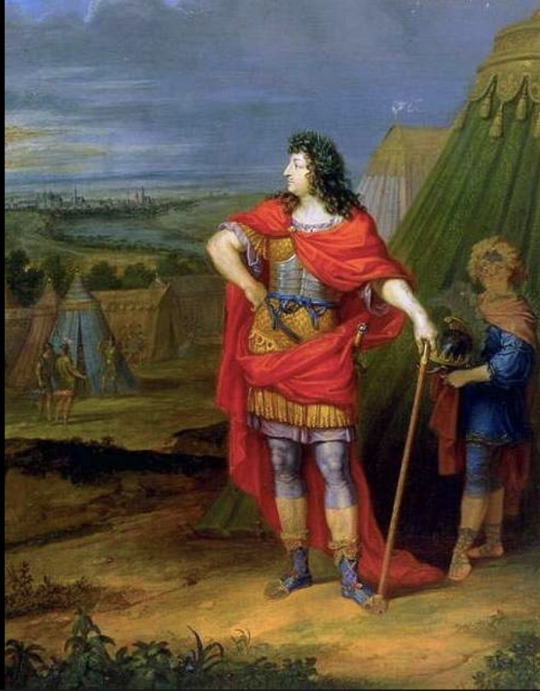
Louis XIV en Empereur Romain [Louis XIV depicted as Alexander the Great] (second half of 17th century) by Unknown artist.
So this piece is difficult as the artist and any info on this one piece is very sparse online.
The painting depicts Louis XIV [Louis the 14th also known as Louis the Great] (September 5 1638 – September 1 1715) who was the king of France from 1643 until his death in 1715 which makes him still currently (as of 2023) the longest (verifiable) reign of reign of 72 years and 110 days which is the most of ANY sovereign whose reign we can verify.
The description of his reign as monarch given on the Versailles official website is:
"As sovereign by divine right, the King was God’s representative on earth. It is in this respect that his power was “absolute”, which in Latin means literally ‘free of all restraints’: the king was answerable to no one but God. During his coronation, Louis XIV swore to defend the Catholic faith. To honour this pledge and preserve the religious unity of his kingdom, he cracked down on the Jansenists of Port-Royal and ordered the persecution of Protestants. The previous policy of religious tolerance was abandoned with the revocation of the Edict of Nantes in 1685. Protestants were forced to convert, and over two hundred thousand fled the country. From his base in Versailles, Louis XIV ruled over a centralised, absolutist state which revolved entirely around him. The King lived in the main wing of the palace, on the first floor, in a suite of three apartments reserved for his use. He applied a strict etiquette at court, a set of rules and protocols by which his noble courtiers were obliged to abide. With the help of Colbert, he oversaw the administrative and financial reorganisation of his realm, and also set up manufactures and worked to boost trade. With Louvois he reformed the army and enjoyed a string of military victories. "[1]
It is most likely a replica based of a lost portirt of Louis XIV as a Roman Emperor painted by the well know Frencch court painter Pierre Mignard. This is due to the many compositional similarities to a copy of this work painted after Pierre Mignard death shown below.

Louis XIV as a Roman Emperor (Copy of lost painting by Pierre Mignard)
Whats note worthy is that in both paintings Louis XIV is not being depicted as himself leading his army in contemporary(for his time) battles but instead being depicted as Alexander the Great.
"Alexander the Great, also known as Alexander III or Alexander of Macedonia, (born 356 BCE, Pella, Macedonia [northwest of Thessaloníki, Greece]—died June 13, 323 BCE, Babylon [near Al-Ḥillah, Iraq]), king of Macedonia (336–323 BCE), who overthrew the Persian empire, carried Macedonian arms to India, and laid the foundations for the Hellenistic world of territorial kingdoms. Alexander the Great was one of the greatest military strategists and leaders in world history. He was also ruthless, dictatorial, and ambitious to the point of regarding himself as divine. His conquests of the Mediterranean states, the Persian empire, and parts of India spread Hellenistic culture across these regions"- Summery from Encyclopedia Britannica. [2]
So by depicting Louis XIV as Alexander the Great the artists are associating Louis XIV's reign and his accomplishments with being on the same scale and impact as Alexander the Great. In terms of the pairings place in VTMB this is especially important because the only place this painting appears is in Sebastian LaCroix's office. Specifically it hangs over the entrance way which makes it one of the two paintings LaCroix faces from his desk. The other painting being Pierre Séguier, Chancelier de France (translated Pierre Séguier, Chancellor of France) oil on canvas 2nd quarter of the 17th century (1660 - 1661) by Charles Le Brun (See part 5). And as I pointed out in my explainting of Pierre Séguier, Chancelier de France, LaCroix's is someone who claimed to be “an officer in Napoleons army” yet has a lot of French Royalists paintings. It is also of note as the only other large paintings of this scale that he has in his office are three different painting of Cain slaying his brother Able by different artist yet it is the paintings of King Louis XIV (whose reign of 72 years and 110 days is the longest of any sovereign in history whose date is verifiable.) and his chancellor of France, Pierre Séguier that he looks directly at from his desk in his Versailles style office. Indicating that these mere HUMAN men*[as far as I know nether were embraced in VTM canon but don’t quote me] are more significant role models to LaCroix then Cane father of all vampires. It also tells us that just how Louis XIV is being depicted as Alexander the Great was used by the artist order to elevate him and his reign as King of France to the same historical significance and prestige as Alexander the Great, LaCroix aspires to elevate his rule as the Prince of LA in Kindred society/history to the same level as both of these human rules have in mortal history if not beyond that. And again despite having three paintings of Cain, all of them at the same height and size yet are to the side rather then across from LaCroix's desk, almost as if they are peripheral. Almost as if Cain's reign as Father of all Vampires and Ruler of the First City of Enoch is below the level of importance/significants of Louis XIV, Alexander the Great and even Pierre Séguier (who wasn't even a reigning Sovereign, just Chancellor of France). The accomplishments and legacy's of all three of these men who were only ever human (again as far as I can tell none of them were ever embraced) are seemingly above that of Cain in LaCroix's mind based on how he's chosen to arrange the paintings in his office, and he may be attempting to hide this fact and would explain why he chose to have having 3 different painting all depicting the Cain slaying his brother Able hanging at the same level as the two painting depicting the legacies of three mortal men.
[1]“Louis XIV .” Palace of Versailles, 17 Feb. 2023, en.chateauversailles.fr/discover/history/great-characters/louis-xiv#the-royal-family.
[2] Walbank, Frank. “Alexander the Great.” Encyclopædia Britannica, Encyclopædia Britannica, inc., 5 Oct. 2023, www.britannica.com/biography/Alexander-the-Great.
#explaining one of vtmb paintings#vtmb#sebastian lacroix#art history#louis xiv#alexander the great#vampire the masquerade
24 notes
·
View notes
Photo
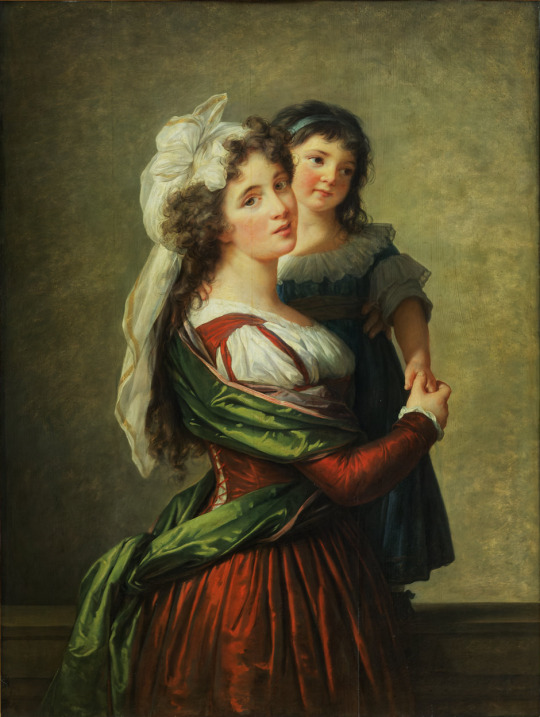
Elisabeth Louise Vigée Le Brun (French, 1755-1842)
Madame Rousseau, femme de l'architecte Pierre Rousseau, et sa fille, 1789
Musée du Louvre
#Elisabeth Louise Vigée Le Brun#1700s#art#fine art#fine arts#classical art#mother and child#motherhood#woman and child#oil painting#europe#european#culture#western civilization#madame rousseau
90 notes
·
View notes
Note
When writing Soult I’d like to mention and write his aides as well, but I don’t think I have a very good grasp on their personalities rather than treating them as a collective excitable drunk blob - if you had to describe each of them in a few words/traits, what would that be?
That's a harder question than I thought because "collective excitable drunk blob" is precisely how I see them, too, most of the time. 😁
So, looking at them a little more closely:
Saint-Chamans: not exactly the brightest one, stubborn, feeling rather entitled, more adventurer than soldier, childlike to the point of childishness
Petiet: similar sense of entitledness, but whinier and somewhat insecure, often feels like he's left out, the "silent kid" (?), loves getting presents, extremely proud when he feels Soult is pleased with him
Lameth: outspoken, rather clever, ambitious and courageous, great sense of humour, also the least scared of his imposing marshal/dragon, dares to contradict him on occasion
Brun: the "good kid" who feels he needs to clean up after his unruly siblings and occasionally even his marshal/dragon, good education, silent, independent thinker, hard worker
That's the main four during the imperial period, I guess, of the others I do not have a very clear picture myself. Little Anthoine de Saint-Joseph seems to have been the Benjamin of the military family, the little one everybody felt they needed to protect a little (and who probably was very proud when the "big brothers" included him in their shenanigans). You could also include Bory de Saint-Vincent as the guy who is always off doing stuff that has nothing to do with the campaign, like collecting plants or drawing landscapes. Not sure what you would do with Pierre Soult and Coco Lefebvre - in your AU, they would need to be dragons, I guess?
Then there's of course Franceschi who started out as Soult's aide but had moved on to become a cavalry general and aide-de-camp to Joseph Bonaparte. He seems to have been very brave personally, but also a very affable, accomodating character, often trying to mediate (between Soult and Saint-Chamans but also Soult and Joseph). As a painter and close friend of Dragon!Soult, maybe Soult would put him in charge of the painting collection?
(And now I have an image in my head of the ADCs clumsily hanging up Soult's treasured hoard of human artwork in whatever place Soult dozes in, with Soult barking orders because the paintings are not placed correctly, are crooked, Louise trying to calm him down and Franceschi finally taking over and arranging the collection as it should be.)
16 notes
·
View notes